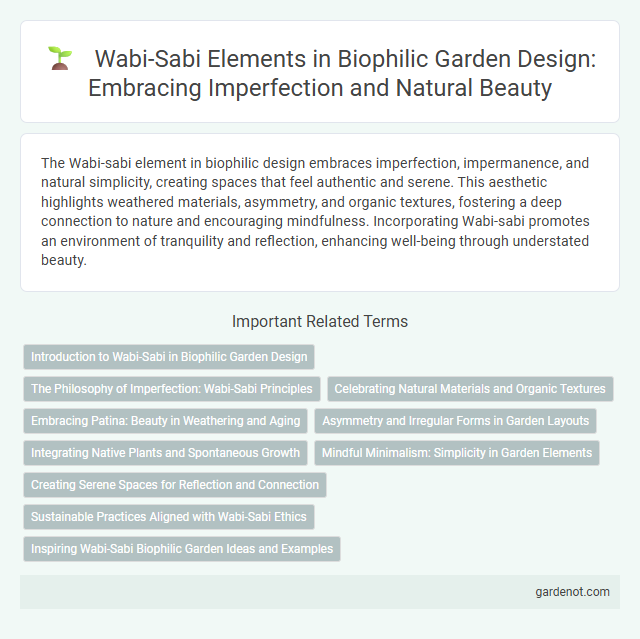The Wabi-sabi element in biophilic design embraces imperfection, impermanence, and natural simplicity, creating spaces that feel authentic and serene. This aesthetic highlights weathered materials, asymmetry, and organic textures, fostering a deep connection to nature and encouraging mindfulness. Incorporating Wabi-sabi promotes an environment of tranquility and reflection, enhancing well-being through understated beauty.
Introduction to Wabi-Sabi in Biophilic Garden Design
Wabi-sabi in biophilic garden design emphasizes the beauty of imperfection and natural aging processes, creating serene spaces that evoke simplicity and authenticity. This Japanese aesthetic celebrates asymmetry, roughness, and the passage of time, fostering a deep connection between occupants and the natural world. Incorporating wabi-sabi elements such as weathered wood, irregular stones, and muted colors enhances the garden's organic charm and promotes mindfulness through subtle, unpretentious beauty.
The Philosophy of Imperfection: Wabi-Sabi Principles
Wabi-sabi embodies the philosophy of imperfection, valuing natural materials that showcase weathering, asymmetry, and simplicity to create authentic, tranquil spaces. Its principles emphasize embracing transience and flaws, reflecting the beauty found in aging, natural textures, and organic forms. This approach enhances biophilic design by fostering a deep connection to nature's cycles and impermanent beauty.
Celebrating Natural Materials and Organic Textures
Wabi-sabi in biophilic design emphasizes the beauty of imperfection by showcasing natural materials such as raw wood, stone, and clay in their authentic, unrefined states. Organic textures like weathered surfaces and asymmetrical forms create a tactile connection to nature, enhancing the sensory experience within interior spaces. This design approach fosters tranquility by embracing the transient and imperfect qualities inherent in natural materials.
Embracing Patina: Beauty in Weathering and Aging
Wabi-sabi embraces patina by valuing the natural wear and aging of materials as a testament to time and experience, enhancing spaces with authentic textures and imperfect beauty. The visible weathering of wood, metal, or stone creates a rich narrative that connects occupants to the passage of time and the impermanence of nature. Incorporating patina in biophilic design fosters a deep emotional resonance and encourages mindfulness through the celebration of organic imperfections.
Asymmetry and Irregular Forms in Garden Layouts
Wabi-sabi embraces the beauty of asymmetry and irregular forms in garden layouts, highlighting natural imperfection and organic flow. This design philosophy encourages the use of uneven pathways, irregular stone arrangements, and asymmetrical plant placements to create serene, authentic outdoor spaces. Emphasizing simplicity and aged textures, wabi-sabi gardens foster a deep connection with nature's transient and imperfect qualities.
Integrating Native Plants and Spontaneous Growth
Wabi-sabi in biophilic design emphasizes the beauty of imperfection through integrating native plants that thrive naturally within their environment, fostering spontaneous growth patterns. This approach enhances ecological resilience and supports local biodiversity by allowing vegetation to evolve freely, reflecting the transient and imperfect nature of life. Incorporating these organic elements creates authentic, harmonious spaces that connect occupants deeply with the natural world.
Mindful Minimalism: Simplicity in Garden Elements
Wabi-sabi emphasizes mindful minimalism by celebrating the natural beauty of imperfection and transience in garden elements. Its simplicity highlights raw textures, organic materials, and asymmetrical forms that foster a serene, contemplative environment. This design philosophy enhances the connection between humans and nature, encouraging presence and tranquility through understated aesthetics.
Creating Serene Spaces for Reflection and Connection
Wabi-sabi embraces imperfection and natural materials to cultivate serene spaces that encourage reflection and deep connection with the environment. This aesthetic highlights organic textures, muted tones, and asymmetrical forms, enhancing emotional tranquility and mindfulness. Integrating worn wood, weathered stone, and handcrafted ceramics fosters a harmonious atmosphere aligned with biophilic principles.
Sustainable Practices Aligned with Wabi-Sabi Ethics
Wabi-sabi principles emphasize the beauty of imperfection and impermanence, promoting sustainable practices such as using natural, locally sourced materials that age gracefully over time. This approach encourages minimal waste by valuing handcrafted, durable items that foster a deep connection with nature and support eco-friendly living. Integrating wabi-sabi ethics into biophilic design enhances environmental responsibility while creating spaces that reflect authentic, organic aesthetics.
Inspiring Wabi-Sabi Biophilic Garden Ideas and Examples
Inspiring Wabi-Sabi biophilic garden ideas emphasize natural imperfection, embracing weathered textures, asymmetrical arrangements, and organic materials like rough stone, aged wood, and moss. Integrating elements such as irregular stepping stones, rustic pottery, and gently weathered garden benches cultivates a serene ambiance that celebrates transient beauty and simplicity. Examples include gardens featuring sparse, uneven plantings, natural water features with unpolished rocks, and muted color palettes that evoke a peaceful, unrefined harmony linked to traditional Japanese aesthetics.
Wabi-sabi element Infographic

 gardenot.com
gardenot.com